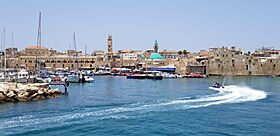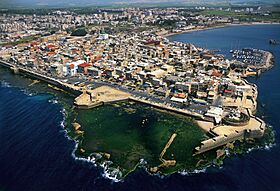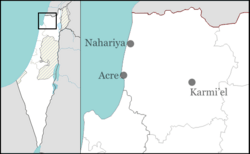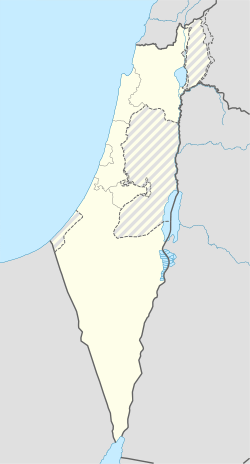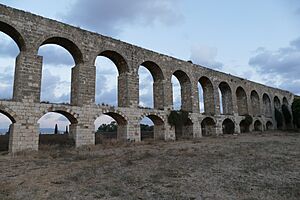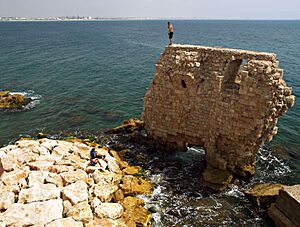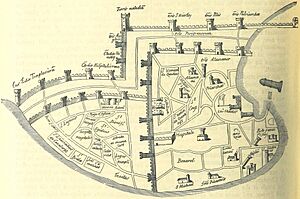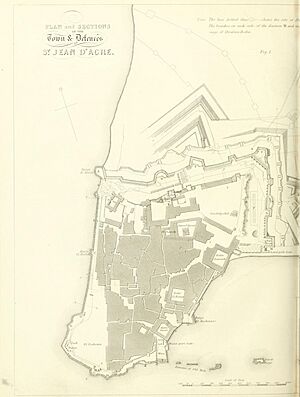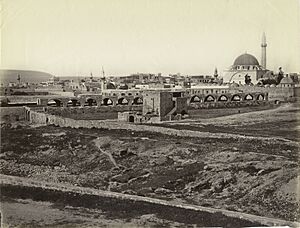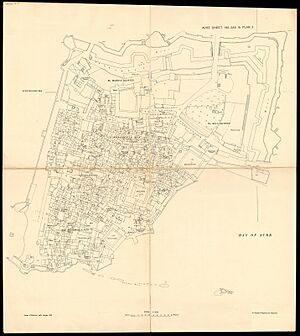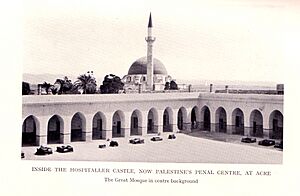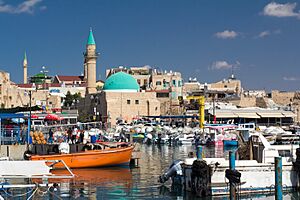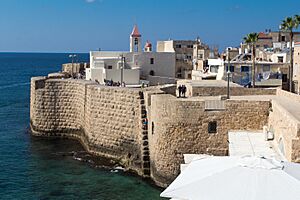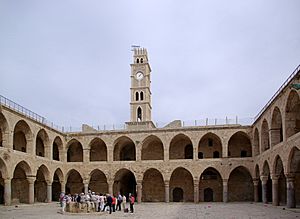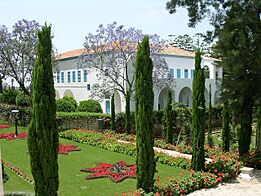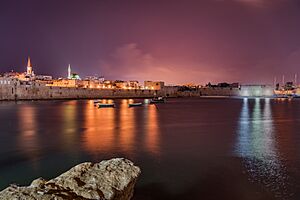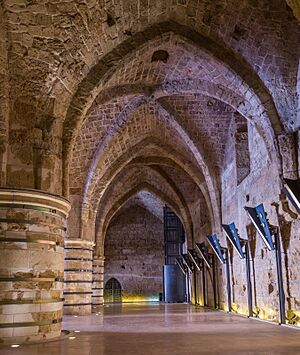Acre, Israel facts for kids
Quick facts for kids
Acre
|
||
|---|---|---|
| Hebrew transcription(s) | ||
| • ISO 259 | ʕAkko | |
|
|
||
|
||
| Country | ||
| District | Northern | |
| Founded | 3000 BC (Bronze Age settlement) 1550 BC (Canaanite settlement) 1104 (Crusader rule) 1291 (Mamluk rule) 1948 (Israeli city) |
|
| Area | ||
| • Total | 13,533 dunams (13.533 km2 or 5.225 sq mi) | |
| Population
(2017)
|
||
| • Total | 48,303 | |
| UNESCO World Heritage Site | ||
| Official name | Old City of Acre | |
| Criteria | Cultural: ii, iii, v | |
| Inscription | 2001 (25th Session) | |
| Area | 63.3 ha | |
| Buffer zone | 22.99 ha | |
Acre (pronounced AH-kər or AY-kər), also known as Akko in Hebrew and Akka in Arabic, is an ancient city in Israel. It is located on the coast of the Mediterranean Sea, in the northern part of the country.
Acre has a very important location. It sits on a natural harbor in Haifa Bay. This made it a key spot for trade by sea. It was also a major stop on old land routes, connecting different parts of the region. Acre is one of the oldest cities in the world where people have lived without stopping. However, it has been conquered and destroyed many times throughout history.
During the Crusades, Acre was a super important city. It was a main port for the Crusaders on the Mediterranean coast. Many big battles happened here, including the Siege of Acre (1189–1191) and the Siege of Acre (1291). It was the very last place the Crusaders held in the Holy Land before they lost it in 1291. After the Crusaders left, the city was destroyed. For a long time, it was just a small fishing village.
Today, Acre is a city in Israel. It has people from different backgrounds, including Jews, Muslims, Christians, Druze, and Baháʼís. Acre is especially holy for the Baháʼí Faith, and many pilgrims visit it every year. About one-third of the city's population is Arab.
Contents
- What's in a Name? The History of Acre's Names
- Acre Through the Ages: A City's Journey
- Early Beginnings: Bronze Age Settlements
- Middle and Late Bronze Age: A City Reborn
- Iron Age: Phoenicians and Assyrians
- Persian and Greek Times: A Busy Port
- Roman Colony: A Time of Growth
- Byzantine Period: Losing Importance
- Early Islamic Period: A New Beginning
- Crusader and Ayyubid Periods: Battles and Fortresses
- Mamluk Period (1291–1517): Destruction and Rebuilding
- Ottoman Period: A City Revives
- Mandatory Palestine: A Time of Change
- Israel: Modern Acre
- Climate: Acre's Weather
- Who Lives in Acre?
- Getting Around Acre: Transportation
- Learning and Fun in Acre: Education and Culture
- Sports in Acre
- Amazing Places to See in Acre: Landmarks
- Archaeology: Uncovering Acre's Past
- Acre Around the World: Sister Cities
- Famous People from Acre
- See also
What's in a Name? The History of Acre's Names
The name "Acre" has a long and interesting history. No one knows for sure where the name comes from.
Some people say that in Hebrew, "Akko" sounds like "ad koh," which means "up to here." This is like saying the ocean expanded until it reached Acre and then stopped.
Acre's name might have been written in ancient Egyptian hieroglyphs around 1800 BC. It also appears in old letters from the 14th century BC.
The ancient Greeks called the city Ákē, which means "cure." A Greek story says that the hero Hercules found special healing plants there after a fight. The Romans later called it Ace.
Over time, the city had many different names:
- Ptolemaïs: Named after a Greek king, Ptolemy II.
- Antioch: Named after another Greek king, Antiochus IV.
- Colonia Ptolemais: A Roman name, given when it became a Roman colony.
- Sainct-Jehan-d'Acre: This was the name used during the Crusades. It means "Saint John of Acre," named after the Knights Hospitaller who had their main base there.
Acre Through the Ages: A City's Journey
Early Beginnings: Bronze Age Settlements
Acre is located at the northern end of a large bay. It has a great natural harbor and easy access to the Valley of Jezreel. Because of this, it was always important for ships and trade. It was the main port for the southern part of the Levant for a very long time.
The oldest part of the city was on a mound called Tel ʿAkkō. The first settlement found here dates back to about 3000 BC. However, it seems people left for a few centuries.
Middle and Late Bronze Age: A City Reborn
Acre became a city again around 2000–1550 BC and has been lived in ever since. Ancient Egyptian records mention Acre as a city conquered by Thutmose III.
Letters from Amarna: Ancient Troubles
Around 1350 BC, during the Amarna Period, there was a lot of trouble in Egypt's provinces. Letters found from this time talk about the rulers of Acre. One letter complains that the king of Acre let a captured enemy leader go instead of sending him to Egypt.
Iron Age: Phoenicians and Assyrians
During the Iron Age, Acre was a Phoenician city. The Assyrians also called it a Phoenician city. Around 725 BC, Acre joined other cities in a revolt against the Assyrian emperor.
Persian and Greek Times: A Busy Port
Acre was a very important port for the Persian Empire. It was used to gather large armies for campaigns against Egypt. The Persians made the town bigger and probably improved its harbor and defenses.
After Alexander the Great died, his generals divided his empire. The Egyptian Ptolemies first controlled Acre. Then, the Syrian Seleucids took over. They both renamed the city.
Roman Colony: A Time of Growth
Around 37 BC, the Romans took over the city. It became a Roman colony called Colonia Ptolemais. Acre stayed Roman for almost 700 years until 638 AD.
The Romans built a breakwater and made the harbor bigger. Acre became a very important port city. Roman armies came by ship through this port. The Acts of the Apostles in the Christian Bible mentions that Paul the Apostle and his friends spent a day in Ptolemais.
During the rule of Emperor Claudius, many Roman soldiers settled here. The city grew to have more than 20,000 people under Emperor Hadrian.
Byzantine Period: Losing Importance
After the Roman Empire split in 395 AD, Acre was ruled by the Byzantine Empire. The city started to become less important and its population shrank.
Early Islamic Period: A New Beginning
In 638 AD, Acre came under the rule of the Rashidun Caliphate. This brought new life to the town. It became the main port of Palestine.
The first Umayyad caliph, Muawiyah I, saw the coastal towns as very important. He made Acre's defenses stronger and brought people from other parts of Muslim Syria to live there. Acre became one of the most important shipyards.
In the 10th century, a geographer described Acre as a strong coastal city with a large mosque. When a Persian traveler visited in 1047, he noted that the mosque was made of marble.
Crusader and Ayyubid Periods: Battles and Fortresses
First Crusader Kingdom (1104–1187)
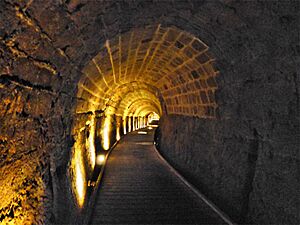
In 1104, the Crusaders took over Acre after a four-year siege. They made it their main port in the Kingdom of Jerusalem. Acre was very important for the Crusaders. It gave them a place to land and access to rich trade routes, especially for spices from Asia. By the 1130s, it had about 25,000 people. It was one of the biggest cities in the Crusader kingdom.
Ayyubid Control (1187–1191)
In 1187, Acre surrendered to the Ayyubid sultan Saladin after his big victory at Hattin.
Second Crusader Kingdom (1191–1291)
Acre stayed in Muslim hands until 1189, when King Guy of Lusignan and forces from Pisa began to besiege it. The city was finally captured in 1191 by the forces of the Third Crusade, led by King Richard I of England and King Philip II of France. Acre then became the capital of the remaining Kingdom of Jerusalem.
During the siege, German merchants started a field hospital, which later became the Teutonic Order. Acre continued to be a major trading center. However, there were often fights between different Crusader groups.
Acre was the last major stronghold of the Crusader states. It fell to the Mamluk Sultan Al-Ashraf Khalil in 1291.
Mamluk Period (1291–1517): Destruction and Rebuilding
After the Mamluks conquered Acre in 1291, they completely destroyed the city. This was to prevent Crusaders from using it again. Only a few religious buildings important to Muslims were left.
In 1321, a geographer wrote that Acre was a "beautiful city" but still mostly in ruins. However, its large port was still being used.
Ottoman Period: A City Revives
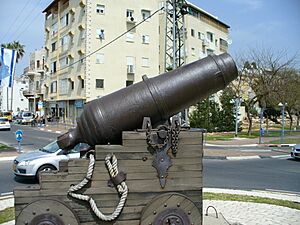
Acre became part of the Ottoman Empire in 1517. For a long time, it was mostly a ruin. But in the late 1700s, it started to revive under the rule of Zahir al-Umar. He rebuilt Acre's defenses using stones from old ruins.
His successor, Jazzar Pasha, made the walls even stronger. He also built many important buildings, like the Al-Jazzar Mosque and the Khan al-Umdan. Under Jazzar, Acre became the third largest city in Ottoman Syria.
In 1799, Napoleon tried to capture Acre, but he was stopped by the Turks and British forces. After a two-month siege, Napoleon had to retreat.
Acre regained some of its wealth after a railway line connected it to Haifa in 1913. The British captured the city in 1918 during World War I.
Mandatory Palestine: A Time of Change
During the time of Mandatory Palestine, Acre's population was mostly Muslim and Christian.
Acre's old fort was turned into a jail. Many Jewish activists were held there during their fight against the British. Some were even executed there. In 1947, Jewish underground groups broke into the jail and freed many prisoners.
Israel: Modern Acre
After the 1948 Arab-Israeli War, many Jewish neighborhoods were built in Acre. The city became a place for new Jewish immigrants, especially from Morocco. The Old City of Acre remained mostly Arab.
Acre also became important for followers of the Baháʼí Faith. Many Baháʼí holy places are in and around Acre. The Mansion of Bahjí, where Baháʼu'lláh (the founder of the Baháʼí Faith) lived his final years, is just outside Acre. His burial place, the Shrine of Baháʼu'lláh, is the holiest place for Baháʼís. In 2008, the Baháʼí holy places in Acre and Haifa were added to the UNESCO World Heritage List.
In the 1990s, many Jews from the former Soviet Union moved to Acre. Today, Acre has a clear Jewish majority, but it is still a city where Jews and Arabs live together.
Climate: Acre's Weather
Acre has a Mediterranean climate. This means it has hot, dry summers and mild, wet winters.
| Climate data for Acre (1991–2020) | |||||||||||||
|---|---|---|---|---|---|---|---|---|---|---|---|---|---|
| Month | Jan | Feb | Mar | Apr | May | Jun | Jul | Aug | Sep | Oct | Nov | Dec | Year |
| Record high °C (°F) | 25.9 (78.6) |
29.2 (84.6) |
36.8 (98.2) |
40.3 (104.5) |
42.0 (107.6) |
44.0 (111.2) |
39.9 (103.8) |
34.6 (94.3) |
40.5 (104.9) |
39.9 (103.8) |
34.5 (94.1) |
29.6 (85.3) |
44.0 (111.2) |
| Mean daily maximum °C (°F) | 17.0 (62.6) |
17.9 (64.2) |
20.2 (68.4) |
23.4 (74.1) |
26.0 (78.8) |
27.9 (82.2) |
29.9 (85.8) |
30.8 (87.4) |
30.0 (86.0) |
28.2 (82.8) |
23.9 (75.0) |
19.0 (66.2) |
24.5 (76.1) |
| Daily mean °C (°F) | 12.2 (54.0) |
12.5 (54.5) |
14.2 (57.6) |
17.0 (62.6) |
19.9 (67.8) |
22.7 (72.9) |
25.4 (77.7) |
26.0 (78.8) |
24.5 (76.1) |
21.6 (70.9) |
17.5 (63.5) |
13.8 (56.8) |
18.9 (66.0) |
| Mean daily minimum °C (°F) | 7.3 (45.1) |
7.1 (44.8) |
8.2 (46.8) |
10.6 (51.1) |
13.7 (56.7) |
17.4 (63.3) |
20.8 (69.4) |
21.2 (70.2) |
18.9 (66.0) |
15.0 (59.0) |
11.1 (52.0) |
8.6 (47.5) |
13.3 (55.9) |
| Record low °C (°F) | −2.1 (28.2) |
−4.0 (24.8) |
−0.8 (30.6) |
−0.3 (31.5) |
5.0 (41.0) |
8.6 (47.5) |
12.8 (55.0) |
13.7 (56.7) |
9.5 (49.1) |
5.5 (41.9) |
−2.0 (28.4) |
−2.6 (27.3) |
−4.0 (24.8) |
| Average precipitation mm (inches) | 162.9 (6.41) |
102.0 (4.02) |
53.7 (2.11) |
24.4 (0.96) |
7.4 (0.29) |
0.4 (0.02) |
0.1 (0.00) |
0.0 (0.0) |
2.5 (0.10) |
27.2 (1.07) |
76.5 (3.01) |
133.9 (5.27) |
591.0 (23.27) |
| Average precipitation days (≥ 1.0 mm) | 11.2 | 9.3 | 6.1 | 2.9 | 1.2 | 0.1 | 0.1 | 0.0 | 0.5 | 2.7 | 5.5 | 10.0 | 49.6 |
| Source: NOAA | |||||||||||||
Who Lives in Acre?
Today, about 48,000 people live in Acre. About one-third of the people living there are Arab. In the Old City, most residents are Arab. Acre is home to Jews, Muslims, Christians, Druze, and Baháʼís. It is a very diverse city.
Getting Around Acre: Transportation
Acre has a central bus station with routes all over Israel. The city also has a train station on the main coastal line. You can take trains south to cities like Beersheba.
Learning and Fun in Acre: Education and Culture
Acre has a special Jewish-Arab Community Centre. It runs clubs and programs for both Jewish and Arab children. One program, "Peace Child Israel," uses theater to teach kids how to solve conflicts and live together. They create plays about issues they explore. Another program, "Patriots of Acre," teaches children to be good citizens and ambassadors for their city.
The Acco Festival of Alternative Israeli Theatre is a yearly event in October. It shows different kinds of theater, bringing together theater groups from Israel and other countries. Both Jewish and Arab artists perform in the city.
Sports in Acre
Acre has a football team called Hapoel Acre F.C.. They play in the top Israeli football league. Their home is the Acre Municipal Stadium, which opened in 2011.
Amazing Places to See in Acre: Landmarks
Acre's Old City is a UNESCO World Heritage Site. This means it's a very important place to protect because of its history and culture. Many old sites have been dug up and are being preserved.
City Walls: Protecting Acre
In 1750, the ruler of Acre, Zahir al-Umar, used parts of the old Crusader walls to build new ones. These walls were made even stronger by Jazzar Pasha between 1775 and 1799. They helped the city survive Napoleon's attack.
A very strong land wall was built north and east of the city between 1800 and 1814. It had thick walls, a dry ditch, and cannon posts. The sea wall is mostly the original wall built by Zahir.
Al-Jazzar Mosque: A Beautiful Place of Worship
The Al-Jazzar Mosque was built in 1781. It is a beautiful mosque where Jazzar Pasha and his successor are buried. Inside, there is a special shrine that holds a single hair from the beard of Muhammad, which is shown on special days.
Hamam al-Basha: The Turkish Bathhouse
The Turkish bath in Acre was built in 1795. It has hot rooms and a steam room with a marble fountain. It was used as a bathhouse until 1950.
Citadel of Acre: A Historic Prison
The Citadel of Acre is an Ottoman fort built on top of an older Crusader fort. It was part of the city's defenses. In the 20th century, it was mainly used as a prison. Many activists were held there, and some were executed.
Hospitaller Fortress: Knights' Headquarters
Underneath the Citadel of Acre, archaeologists found a large complex of halls. These were built and used by the Knights Hospitaller. This complex was part of their fortress and helped defend Acre. It includes large halls, a dungeon, a dining room, and parts of an old Gothic church.
Other Old Sites to Explore
Other old European sites include the Church of Saint George. There were also areas where merchants from cities like Pisa and Amalfi lived and traded.
Baháʼí Holy Places: A Spiritual Journey
Acre is home to many holy places for the Baháʼí Faith. This is because Baháʼu'lláh, the founder of the faith, was imprisoned in the Citadel of Acre. He spent his last years in the Mansion of Bahjí just outside the city. The Shrine of Baháʼu'lláh is where he is buried, and it is the holiest place for Baháʼís. Other Baháʼí sites in Acre include the House of ʻAbbúd and the House of ʻAbdu'lláh Páshá. The Garden of Ridván is also a special place.
Archaeology: Uncovering Acre's Past
Archaeologists have been digging at Tel Akko since 1973. In 2012, they found parts of a 2,300-year-old port near the city's southern seawall. They found large stones that were used to tie up ships.
Crusader Discoveries
Under the Citadel of Acre, archaeologists found a network of halls used by the Knights Hospitaller. These halls were part of their fortress. They include six connected halls, a dungeon, a dining room, and parts of an old Gothic church.
In 2017, marine archaeologists found the remains of a Crusader ship with treasure from 1062-1250 AD. They also found pottery from places like Syria and Italy.
Acre Around the World: Sister Cities
Acre is twinned with several cities around the world. This means they have special friendly relationships.
|
|
Famous People from Acre
Many notable people have connections to Acre, including:
- Joan of Acre (1272–1307), an English princess born in Acre.
- Mahmoud Darwish (1941–2008), a famous Palestinian poet.
- Rivka Zohar (born 1948), an Israeli singer.
- Lydia Hatuel-Czuckermann (born 1963), an Olympic fencer.
- Delila Hatuel (born 1980), also an Olympic fencer.
- Avigail Alfatov (born 1996), a national fencing champion and Miss Israel 2014.
See also
 In Spanish: Acre (Israel) para niños
In Spanish: Acre (Israel) para niños






